21
[latexpage]
So far we have focused on a linear measurement model, using the number line. But there’s another common way to think about multiplication: using area.
For example, suppose our basic unit is one square:

We can picture 4 × 3 as 4 groups, with 3 squares in each group, all lined up:




But we can also picture them stacked up instead of lined up. We would have 4 rows, with 3 squares in each row, like this:
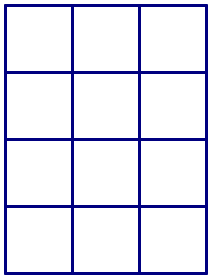
So we can think about 4 × 3 as a rectangle that has length 3 and width 4. The product, 12, is the total number of squares in that rectangle. (That is also the area of the rectangle, since each square was one unit!)
Think / Pair / Share
Vera drew this picture as a model for 15 × 17. Use her picture to help you compute 15 × 17. Explain your work.
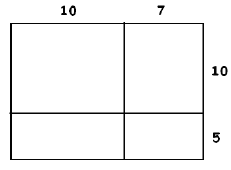
Problem 8
Draw pictures like Vera’s for each of these multiplication exercises. Use your pictures to find the products without using a calculator or the standard algorithm.
23 × 37 8 × 43 371 × 42
The Standard Algorithm for Multiplication
How were you taught to compute 83 × 27 in school? Were you taught to write something like the following?

Or maybe you were taught to put in the extra zeros rather than leaving them out?

This is really no different than drawing the rectangle and using Vera’s picture for calculating!
Think / Pair / Share
- Use the example above to explain why Vera’s rectangle method and the standard algorithm are really the same.
- Calculate the products below using both methods. Explain where you’re computing the same pieces in each algorithm.
23 × 14 106 × 21 213 × 31
Lines and Intersections
Here’s an unusual way to perform multiplication. To compute 22 × 13, for example, draw two sets of vertical lines, the left set containing two lines and the right set two lines (for the digits in 22) and two sets of horizontal lines, the upper set containing one line and the lower set three (for the digits in 13).
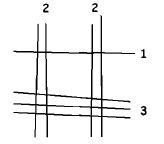
There are four sets of intersection points. Count the number of intersections in each and add the results diagonally as shown:
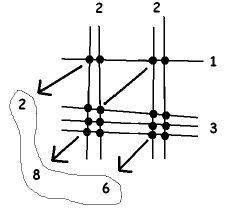
The answer 286 appears!
There is one possible glitch as illustrated by the computation 246 × 32:
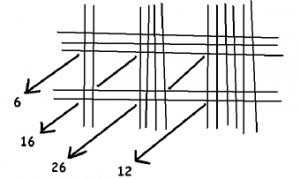
Although the answer 6 thousands, 16 hundreds, 26 tens, and 12 ones is absolutely correct, one needs to carry digits and translate this as 7,872.
Problem 9
- Compute 131 × 122 via this method. Check your answer using another method.
- Compute 15 × 1332 via this method. Check your answer using another method.
- Can you adapt the method to compute 102 × 3054? (Why is some adaptation necessary?)
- Why does the method work in general?
Lattice Multiplication
In the 1500s in England, students were taught to compute multiplication using following galley method, now more commonly known as the lattice method.
To multiply 43 and 218, for example, draw a 2 × 3 grid of squares. Write the digits of the first number along the right side of the grid and the digits of the second number along the top.
Divide each cell of the grid diagonally and write in the product of the column digit and row digit of that cell, separating the tens from the units across the diagonal of that cell. (If the product is a one digit answer, place a 0 in the tens place.)
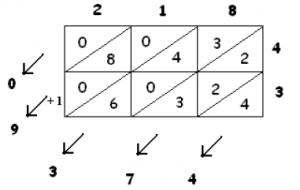
To get the answer, add the entries in each diagonal, carrying tens digits over to the next diagonal if necessary. In our example, we have
\[218 \times 43 = 9374.\]
Problem 10
- Compute 5763 × 345 via the lattice method.
- Explain why the lattice method is really the standard algorithm in disguise.
- What is the specific function of the diagonal lines in the grid?

